The Application of SWAT Model and Remotely Sensed Products to Characterize the Dynamic of Streamflow and Snow in a Mountainous Watershed in the High Atlas
Abstract
1. Introduction
2. Materials and Methods
2.1. Study Area
2.2. Soil and Water Assessment Tool
2.3. Data Preparation
2.3.1. Land Coverage from Multi-Spectral Satellite Products
2.3.2. Digital Elevation Model
2.3.3. Soil Data
2.3.4. Hydroclimatic Data
2.4. MODIS Snow Coverage Data
2.4.1. Data Availability
2.4.2. Cloud Removal Procedure
- The initial step of this procedure is to pre-process the data to reduce the edge effects of snow and cloud detection in MOD16A1. A simple mean filter was employed to reclassify only snow or cloud pixels depending on their surroundings. Within a user-defined grid, if the surrounding pixels had more snow pixels than cloud pixels, the pixel is reclassified as snow; otherwise, the pixel is reclassified as cloudy.
- The second phase involves creating a conservative temporal filter based on the assumption that no change should occur within a short period (i.e., detected changes can be due to clouds only). In this phase, a cloudy pixel is reclassified as snow if there was snow the prior or the next day at the same pixel. If the previous or following days were cloudy, values from two days before or after are also examined. If both were snow, the pixel is turned to snow; otherwise, the pixel is left as cloud.
- The third stage consists of applying a spatial filter, which takes advantage of the elevation dependency of the snow cover. On any given day, the mean elevation of all snowy pixels is calculated. Then, all cloudy pixels with an altitude above this elevation are reclassified as snow.
- Finally, a fourth step consists of a greedy temporal filter replacing the rest of the cloudy pixels with the nearest non-cloudy ones. In this step, the next non-cloudy pixel, either forward or backward in time, was employed to fill the cloudy pixel. If the next non-cloudy pixel was an equal number of days in both directions, the backward value was used.
2.5. Model Performance, Calibration, and Validation
2.5.1. Performance and Uncertainty Analysis
2.5.2. Model Calibration and Validation
3. Results
3.1. Streamflow Performance
3.2. Evaluation of Snow Simulation Using MODIS-SCA
3.2.1. Areal Coverage by MODIS and Its Relationship with SWE
3.2.2. Temporal Evaluation of MODIS-SCA vs. SWAT-SCA
3.2.3. Spatial Resolution
3.2.4. Elevation vs. Snow
4. Discussion
4.1. The SWAT Spatial Representation of Snow and Its Evaluation Using Satellite Snow Coverage from MODIS
4.2. SCA-SWE Relationship
4.3. The Integration of MODIS in the SWAT Model
4.4. Snow Dynamics over the Studied Area
5. Conclusions and Limitations
Author Contributions
Funding
Data Availability Statement
Acknowledgments
Conflicts of Interest
Appendix A. SWAT Simulation of Streamflow
Appendix A.1. Parameters Uncertainties
| Name of Parameter | Description | Changing Method | Range Min/Max | Fitted Value | |||
|---|---|---|---|---|---|---|---|
| Tizi Nisly | Tillouguite | Ait Ouchene | Bine EL Oudiane | ||||
| PLAPS.sub | Precipitation lapse rate (°C/km) | Replace | −100/300 | [146.14:200.94] | [265.66:169.06] | [84.59:54.37] | [29.55:18.54] |
| TLAPS.sub | Temperature lapse rate (mm/km) | Replace | −6/6 | [−5.84:−3.71] | [−6.79:−3.88] | [−3.33:−7.78] | [−4.52:−2.90] |
| Scenario | Parameter | Description | Changing Method | Optimal Range | |||
|---|---|---|---|---|---|---|---|
| Tizi Nisly | Tillouguite | Ait Ouchene | Bine EL Oudiane | ||||
| S1 | TIMP.bsn | Snowpack temperature lag factor (-) | Replace | [0.43:0.24] | |||
| SFTMP.bsn | Snowfall temperature (°C) | Replace | [−0.32:−0.61] | ||||
| SMTMP.bsn | Snowmelt base temperature (°C) | Replace | [0.05:−0.03] | ||||
| SMFMX.bsn | Maximum melt rate for snow during year (mm H2O/°C-day) | Replace | [8.118:6.34] | ||||
| SMFMN.bsn | Minimum melt rate for snow during the year (mm H2O/°C-day) | Replace | [1.34:0.13] | ||||
| SNOCOVMX | Minimum snow water content that corresponds to 100% snow cover [mm] | Replace | [18.01:24.56] | ||||
| SNO50COV | Fraction of snow volume represented by SNOCOVMX that corresponds to 50% snow cover | Replace | [0.1:0.9] | ||||
| S2 | SUB_TIMP.sno | Snowpack temperature lag factor (-) | Replace | [0.62:0.14] | [0.46:0.15] | [0.58:0.22] | [0.44:0.04] |
| SUB_SFTMP.sno | Snowfall temperature (°C) | Replace | [0.4: −0.34] | [−0.13:−0.76] | [0.15:−0.29] | [0.63:−0.65] | |
| SUB_SMTMP.sno | Snowmelt base temperature (°C) | Replace | [0.52:0.05] | [1.13:0.14] | [0.1:−0.2] | 0.5:−0.89] | |
| SUB_SMFMX.sno | Maximum melt rate for snow during year (mm H2O/°C-day) | Replace | [8.23:6.48] | [6.91:5.21] | [8.32:4.51] | [6.92:4.12] | |
| SUB_SMFMN.sno | Minimum melt rate for snow during the year (mm H2O/°C-day) | Replace | [1.82:1.39] | [1.05:0.12] | [1.45:0.61] | [1.4:0.44] | |
| SUB_SNOCOVMX.sno | Minimum snow water content that corresponds to 100% snow cover [mm] | Replace | [12.67:18.40] | [15.58:31.30] | [16.92:24.65] | [12.11:28.49] | |
| SUB_SNO50COV.sno | Fraction of snow volume represented by SNOCOVMX that corresponds to 50% snow cover | Replace | [0.23:0.77] | [0.30:0.81] | [0.21:0.76] | [0.17:0.63] | |
| Parameter | Description | Changing Method | Model | Fitted Value | |||
|---|---|---|---|---|---|---|---|
| Tizi Nisly | Tillouguite | Ait Ouchene | Bine EL Oudiane | ||||
| CANMX.hru | Maximum canopy storage (mm H2O) | Replace | S1 | [12.07, 15.81] | [3.22, 5.53] | [10.18, 14.61] | [14.81, 20.06] |
| S2 | [8.45, 14.69] | [2.25, 5.14] | [7.11, 13.58] | [10.34, 18.65] | |||
| CH_N2.rte | Manning’s “n” value for the main channel (-) | Replace | S1 | [0.05, 0.07] | [0.03, 0.04] | [0.06, 0.09] | [0.03, 0.04] |
| S2 | [0.01, 0.14] | [0.01, 0.08] | [0.02, 0.18] | [0.01, 0.08] | |||
| CH_K2.rte | Effective hydraulic conductivity in main channel alluvium (-) | Replace | S1 | [12.77, 19.41] | [8.22, 10.99] | [10.33, 11.85] | [51.52, 75.68] |
| S2 | [9.21, 20.99] | [5.93, 11.88] | [7.45, 12.81] | [37.16, 81.81] | |||
| CN2.mgt | Curve number (-) | Relative | S1 | [−0.15, −0.29] | [−0.22, −0.28] | [−0.19, −0.24] | [−0.15, −0.22] |
| S2 | [−0.12, −0.47] | [−0.18, −0.45] | [−0.16, −0.39] | [−0.11, −0.24] | |||
| OV_N.hru | Manning’s “n” value for overland flow (-) | Replace | S1 | [0.07, 0.11] | [ 0.05, 0.14] | [0.01, 0.02 ] | [0.01, 0.04] |
| S2 | [0.09, 0.16] | [ 0.01, 0.17] | [0.01, 0.08 ] | [0.01, 0.03] | |||
| SLSOIL.hru | Slope length for lateral subsurface flow (m) | Replace | S1 | [11.60, 16.32] | [20.61, 24.34] | [11.75, 12.86] | [33.12, 49.49] |
| S2 | [10.07, 18.90] | [17.89, 28.19] | [10.20, 14.89] | [28.75, 57.3] | |||
| SOL_AWC.sol | Available water capacity of the soil (mm H2O mm soil-1) | Relative | S1 | [0.03, 0.09] | [0.29, 0.37] | [−0.09, −0.12] | [0.06, 0.08] |
| S2 | [0.02, 0.12] | [0.19, 0.49] | [−0.06, −0.16] | [0.04, 0.11] | |||
| ESCO.hru | Soil evaporation compensation factor (-) | Replace | S1 | [0.64, 0.96] | [0.62, 0.81] | [0.60, 0.96] | [0.71, 0.98] |
| S2 | [0.67, 0.86] | [0.65, 0.73] | [0.63, 0.96] | [0.75, 0.94] | |||
| SOL_CRK.sol | Maximum crack volume of the soil profile expressed as a fraction of the total soil volume | Relative | S1 | [0.02, 0.03] | [0.10, 0.16] | [0.11, 0.17] | [0.08, 0.12] |
| S2 | [0.02, 0.12] | [0.06, 0.14] | [0.07, 0.19] | [0.08, 0.15] | |||
| LAT_TTIME.hru | Lateral flow travel time (day) | Replace | S1 | [2.60, 3.00] | [10.01, 11.11] | [8.62, 10.74] | [14.24, 18.98] |
| S2 | [2.77, 2.91] | [10.66, 10.78] | [9.18, 10.42] | [15.17, 18.41] | |||
| ALPHA_BF.gw | Baseflow alpha factor (-) | Replace | S1 | [0.50, 0.61] | [0.29, 0.51] | [0.32, 0.36] | [0.29, 0.34] |
| S2 | [0.39, 0.65] | [0.23, 0.54] | [0.25, 0.38] | [0.23, 0.36] | |||
Appendix A.2. Graphical Comparison between Simulations and Streamflow
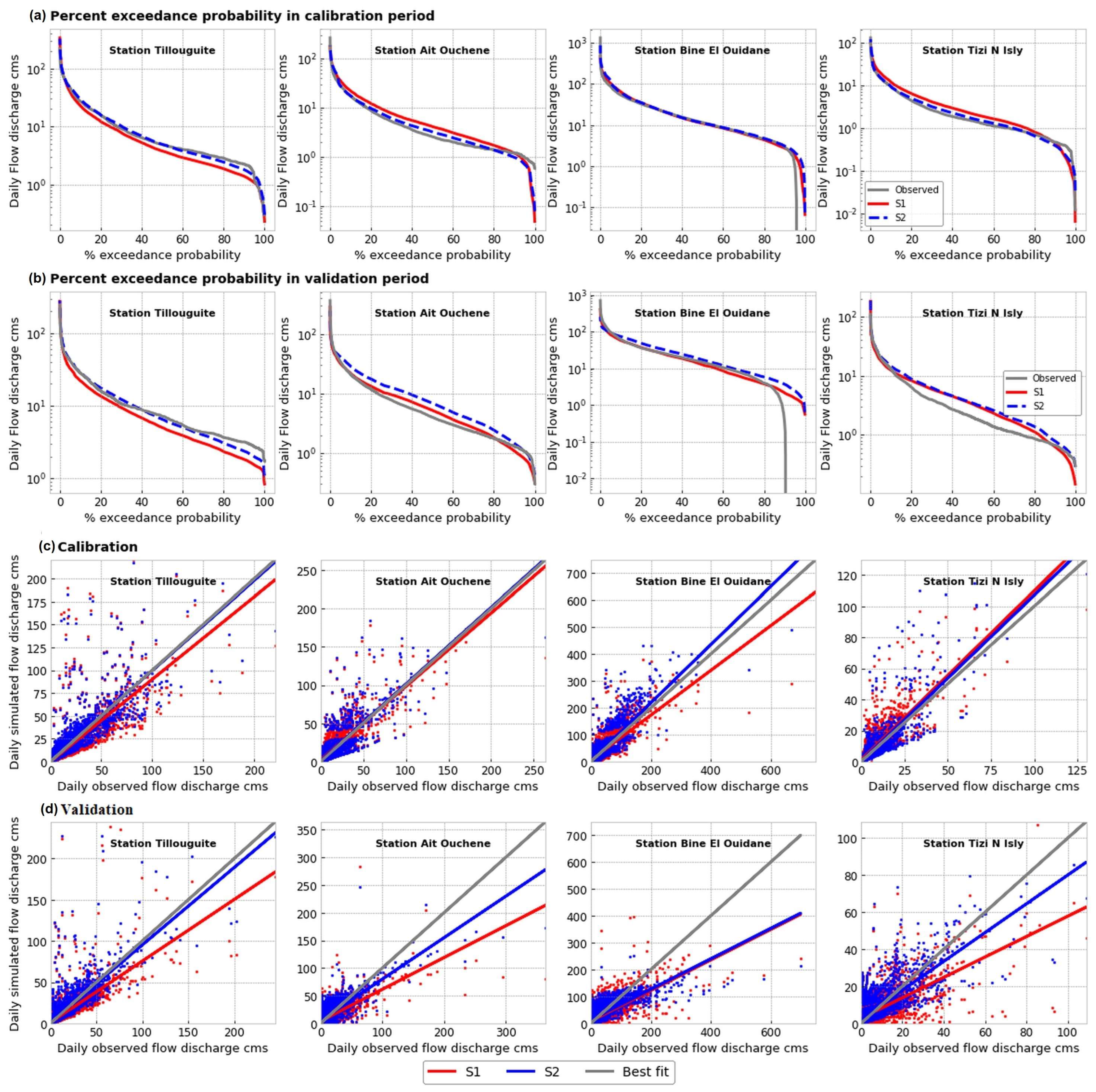

Appendix A.3. Impact of Different Configurations on Water Balance
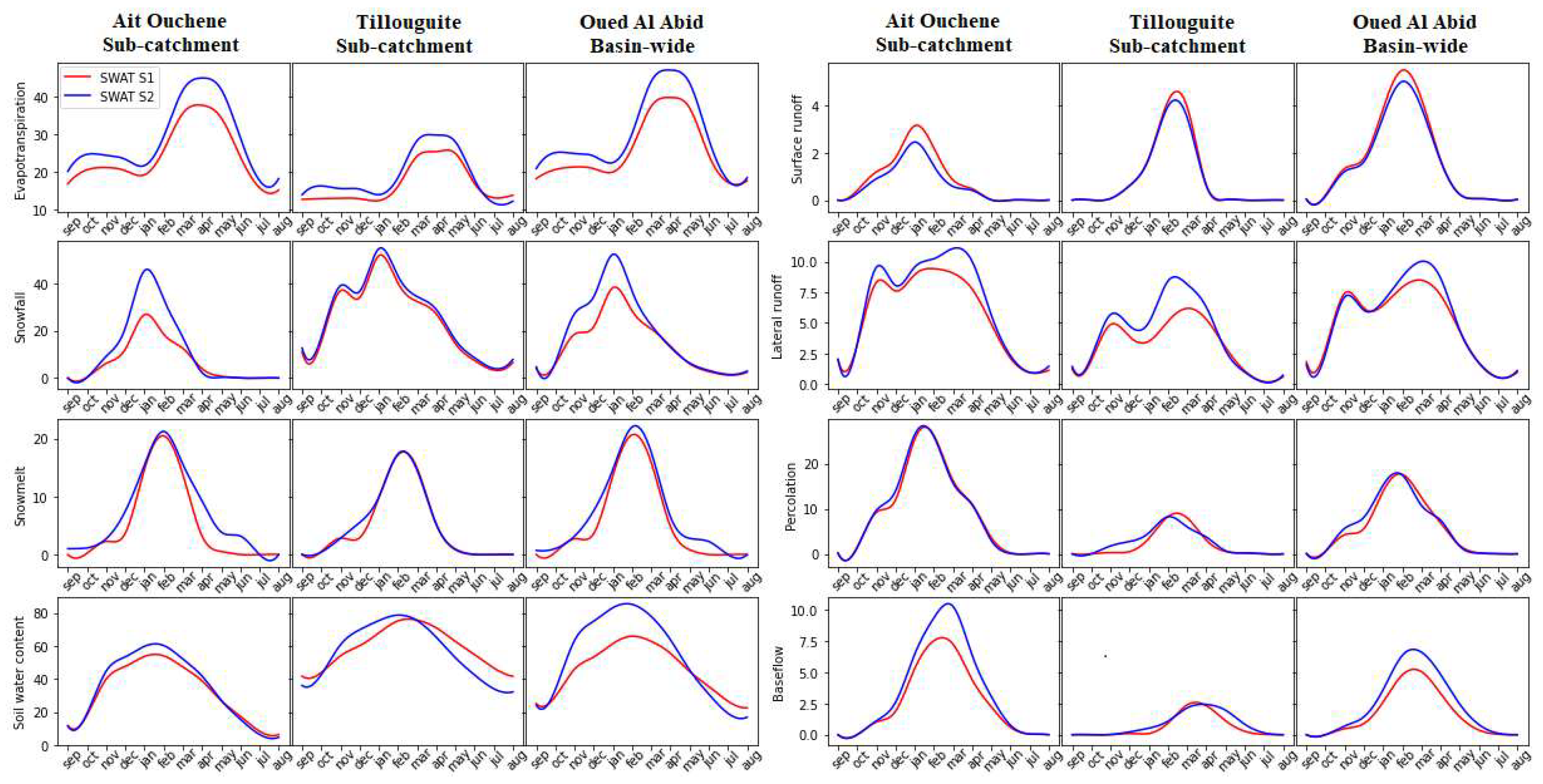
References
- Viviroli, D.; Dürr, H.H.; Messerli, B.; Meybeck, M.; Weingartner, R. Mountains of the World, Water Towers for Humanity: Typology, Mapping, and Global Significance. Water Resour. Res. 2007, 43, W07447. [Google Scholar] [CrossRef]
- Immerzeel, W.W.; Lutz, A.F.; Andrade, M.; Bahl, A.; Biemans, H.; Bolch, T.; Hyde, S.; Brumby, S.; Davies, B.J.; Elmore, A.C.; et al. Importance and Vulnerability of the World’s Water Towers. Nature 2020, 577, 364–369. [Google Scholar] [CrossRef] [PubMed]
- Chehbouni, A.; Escadafal, R.; Duchemin, B.; Boulet, G.; Simonneaux, V.; Dedieu, G.; Mougenot, B.; Khabba, S.; Kharrou, H.; Maisongrande, P.; et al. An Integrated Modelling and Remote Sensing Approach for Hydrological Study in Arid and Semi-arid Regions: The SUDMED Programme. Int. J. Remote Sens. 2008, 29, 5161–5181. [Google Scholar] [CrossRef]
- Jarlan, L.; Khabba, S.; Er-Raki, S.; Page, M.L.; Hanich, L.; Fakir, Y.; Merlin, O.; Mangiarotti, S.; Gascoin, S.; Ezzahar, J.; et al. Remote Sensing of Water Resources in Semi-Arid Mediterranean Areas: The Joint International Laboratory TREMA. Int. J. Remote Sens. 2015, 36, 4879–4917. [Google Scholar] [CrossRef]
- Marchane, A.; Jarlan, L.; Hanich, L.; Boudhar, A.; Gascoin, S.; Tavernier, A.; Filali, N.; le Page, M.; Hagolle, O.; Berjamy, B. Assessment of Daily MODIS Snow Cover Products to Monitor Snow Cover Dynamics over the Moroccan Atlas Mountain Range. Remote Sens. Environ. 2015, 160, 72–86. [Google Scholar] [CrossRef]
- Boudhar, A.; Ouatiki, H.; Bouamri, H.; Lebrini, Y.; Karaoui, I.; Hssaisoune, M.; Arioua, A.; Benabdelouahab, T. Hydrological Response to Snow Cover Changes Using Remote Sensing over the Oum Er Rbia Upstream Basin, Morocco. In Mapping and Spatial Analysis of Socio-Economic and Environmental Indicators for Sustainable Development; Springer: Cham, Switzerland, 2020; pp. 95–102. [Google Scholar]
- Tuel, A.; Chehbouni, A.; Eltahir, E.A.B. Dynamics of Seasonal Snowpack over the High Atlas. J. Hydrol. 2021, 595, 125657. [Google Scholar] [CrossRef]
- Hanich, L.; Chehbouni, A.; Gascoin, S.; Boudhar, A.; Jarlan, L.; Tramblay, Y.; Boulet, G.; Marchane, A.; Baba, M.W.; Kinnard, C.; et al. Snow Hydrology in the Moroccan Atlas Mountains. J. Hydrol. Reg. Stud. 2022, 42, 101101. [Google Scholar] [CrossRef]
- Dong, C. Remote Sensing, Hydrological Modeling and in Situ Observations in Snow Cover Research: A Review. J. Hydrol. 2018, 561, 573–583. [Google Scholar] [CrossRef]
- Helmert, J.; Şensoy Şorman, A.; Alvarado Montero, R.; de Michele, C.; de Rosnay, P.; Dumont, M.; Finger, D.C.; Lange, M.; Picard, G.; Potopová, V. Review of Snow Data Assimilation Methods for Hydrological, Land Surface, Meteorological and Climate Models: Results from a Cost Harmosnow Survey. Geosciences 2018, 8, 489. [Google Scholar] [CrossRef]
- Pradhanang, S.M.; Anandhi, A.; Mukundan, R.; Zion, M.S.; Pierson, D.C.; Schneiderman, E.M.; Matonse, A.; Frei, A. Application of SWAT Model to Assess Snowpack Development and Streamflow in the Cannonsville Watershed, New York, USA. Hydrol. Process 2011, 25, 3268–3277. [Google Scholar] [CrossRef]
- Fassnacht, S.R. A Call for More Snow Sampling. Geosciences 2021, 11, 435. [Google Scholar] [CrossRef]
- Grusson, Y.; Sun, X.; Gascoin, S.; Sauvage, S.; Raghavan, S.; Anctil, F.; Sáchez-Pérez, J.-M. Assessing the Capability of the SWAT Model to Simulate Snow, Snow Melt and Streamflow Dynamics over an Alpine Watershed. J. Hydrol. 2015, 531, 574–588. [Google Scholar] [CrossRef]
- Arnold, J.G.; Allen, P.M.; Muttiah, R.; Bernhardt, G. Automated Base Flow Separation and Recession Analysis Techniques. Groundwater 1995, 33, 1010–1018. [Google Scholar] [CrossRef]
- Nguyen, H.T.; Duong, T.Q.; Nguyen, L.D.; Vo, T.Q.N.; Tran, N.T.; Dang, P.D.N.; Nguyen, L.D.; Dang, C.K.; Nguyen, L.K. Development of a Spatial Decision Support System for Real-Time Flood Early Warning in the Vu Gia-Thu Bon River Basin, Quang Nam Province, Vietnam. Sensors 2020, 20, 1667. [Google Scholar] [CrossRef]
- Bouslihim, Y.; Rochdi, A.; Paaza, N.E.A.; Liuzzo, L. Understanding the Effects of Soil Data Quality on SWAT Model Performance and Hydrological Processes in Tamedroust Watershed (Morocco). J. Afr. Earth Sci. 2019, 160, 103616. [Google Scholar] [CrossRef]
- Brouziyne, Y.; Belaqziz, S.; Benaabidate, L.; Aboubdillah, A.; el Bilali, A.; Elbeltagi, A.; Tzoraki, O.; Chehbouni, A. Modeling Long Term Response of Environmental Flow Attributes to Future Climate Change in a North African Watershed (Bouregreg Watershed, Morocco). Ecohydrol. Hydrobiol. 2022, 22, 155–167. [Google Scholar] [CrossRef]
- Taia, S.; Erraioui, L.; Mbrenga, N.C.; Chao, J.; el Mansouri, B.; Haida, S.; Taj-Eddine, K. Assessment of Soil Erosion Using Two Spatial Approaches: RUSLE and SWAT Model. E3S Web Conf. 2021, 234, 82. [Google Scholar] [CrossRef]
- Echogdali, F.Z.; Boutaleb, S.; Taia, S.; Ouchchen, M.; Id-Belqas, M.; Kpan, R.B.; Abioui, M.; Aswathi, J.; Sajinkumar, K.S. Assessment of Soil Erosion Risk in a Semi-Arid Climate Watershed Using SWAT Model: Case of Tata Basin, South-East of Morocco. Appl. Water Sci. 2022, 12, 137. [Google Scholar] [CrossRef]
- Erraioui, L.; Mafhoum, N.; Taia, S.; Chao, J.; el Mansouri, B.; Haida, S.; Taj-Eddine, K. Assessment of the Relative Impacts of Climate Changes and Anthropogenic Forcing on Ouergha Watershed Hydrology (North-East of Morocco). E3S Web Conf. 2022, 336, 27. [Google Scholar] [CrossRef]
- El Hmaidi, A.; Chadli, K.; Essahlaoui, A.; el Ouali, A.; Taia, S. Hydrological Modeling of Water and Soil Resources in the Basin Upstream of the Allal El Fassi Dam (Upper Sebou Watershed, Morocco). Model Earth Syst. Environ. 2019, 5, 1163–1177. [Google Scholar]
- El Harraki, W.; Ouazar, D.; Bouziane, A.; el Harraki, I.; Hasnaoui, D. Streamflow Prediction Upstream of a Dam Using SWAT and Assessment of the Impact of Land Use Spatial Resolution on Model Performance. Environ. Process. 2021, 8, 1165–1186. [Google Scholar] [CrossRef]
- Lettenmaier, D.P.; Alsdorf, D.; Dozier, J.; Huffman, G.J.; Pan, M.; Wood, E.F. Inroads of Remote Sensing into Hydrologic Science during the WRR Era. Water Resour. Res. 2015, 51, 7309–7342. [Google Scholar] [CrossRef]
- Largeron, C.; Dumont, M.; Morin, S.; Boone, A.; Lafaysse, M.; Metref, S.; Cosme, E.; Jonas, T.; Winstral, A.; Margulis, S.A. Toward Snow Cover Estimation in Mountainous Areas Using Modern Data Assimilation Methods: A Review. Front. Earth Sci. 2020, 8, 325. [Google Scholar] [CrossRef]
- Rittger, K.; Bormann, K.J.; Bair, E.H.; Dozier, J.; Painter, T.H. Evaluation of VIIRS and MODIS Snow Cover Fraction in High-Mountain Asia Using Landsat 8 OLI. Front. Remote Sens. 2021, 2, 647154. [Google Scholar] [CrossRef]
- Revuelto, J.; Alonso-González, E.; Gascoin, S.; Rodríguez-López, G.; López-Moreno, J.I. Spatial Downscaling of MODIS Snow Cover Observations Using Sentinel-2 Snow Products. Remote Sens. 2021, 13, 4513. [Google Scholar] [CrossRef]
- Hao, X.; Huang, G.; Zheng, Z.; Sun, X.; Ji, W.; Zhao, H.; Wang, J.; Li, H.; Wang, X. Development and Validation of a New MODIS Snow-Cover-Extent Product over China. Hydrol. Earth Syst. Sci. 2022, 26, 1937–1952. [Google Scholar] [CrossRef]
- Hall, D.K.; Riggs, G.A. Accuracy Assessment of the MODIS Snow Products. Hydrol. Process. Int. J. 2007, 21, 1534–1547. [Google Scholar] [CrossRef]
- Hussain, D.; Kuo, C.-Y.; Hameed, A.; Tseng, K.-H.; Jan, B.; Abbas, N.; Kao, H.-C.; Lan, W.-H.; Imani, M. Spaceborne Satellite for Snow Cover and Hydrological Characteristic of the Gilgit River Basin, Hindukush–Karakoram Mountains, Pakistan. Sensors 2019, 19, 531. [Google Scholar] [CrossRef]
- Peker, I.B.; Sorman, A.A. Application of SWAT Using Snow Data and Detecting Climate Change Impacts in the Mountainous Eastern Regions of Turkey. Water 2021, 13, 1982. [Google Scholar] [CrossRef]
- di Marco, N.; Avesani, D.; Righetti, M.; Zaramella, M.; Majone, B.; Borga, M. Reducing Hydrological Modelling Uncertainty by Using MODIS Snow Cover Data and a Topography-Based Distribution Function Snowmelt Model. J. Hydrol. 2021, 599, 126020. [Google Scholar] [CrossRef]
- Haq, M.A.; Baral, P.; Yaragal, S.; Pradhan, B. Bulk Processing of Multi-Temporal Modis Data, Statistical Analyses and Machine Learning Algorithms to Understand Climate Variables in the Indian Himalayan Region. Sensors 2021, 21, 7416. [Google Scholar] [CrossRef]
- Dong, C. Assessing the Availability of Remote Sensing, Hydrological Modeling and in Situ Observations in Snow Cover Research. Ph.D. Thesis, Heidelberg University, Heidelberg, Germany, 2016. [Google Scholar]
- Stehr, A.; Debels, P.; Arumi, J.L.; Romero, F.; Alcayaga, H. Combining the Soil and Water Assessment Tool (SWAT) and MODIS Imagery to Estimate Monthly Flows in a Data-Scarce Chilean Andean Basin. Hydrol. Sci. J. 2009, 54, 1053–1067. [Google Scholar] [CrossRef]
- Arnold, J.G.; Moriasi, D.N.; Gassman, P.W.; Abbaspour, K.C.; White, M.J.; Srinivasan, R.; Santhi, C.; Harmel, R.D.; van Griensven, A.; van Liew, M.W. SWAT: Model Use, Calibration, and Validation. Trans. ASABE 2012, 55, 1491–1508. [Google Scholar] [CrossRef]
- Sandu, I.; van Niekerk, A.; Shepherd, T.G.; Vosper, S.B.; Zadra, A.; Bacmeister, J.; Beljaars, A.; Brown, A.R.; Dörnbrack, A.; McFarlane, N. Impacts of Orography on Large-Scale Atmospheric Circulation. NPJ Clim. Atmos. Sci. 2019, 2, 10. [Google Scholar] [CrossRef]
- Momblanch, A.; Holman, I.P.; Jain, S.K. Current Practice and Recommendations for Modelling Global Change Impacts on Water Resource in the Himalayas. Water 2019, 11, 1303. [Google Scholar] [CrossRef]
- Zhang, X.; Srinivasan, R.; Debele, B.; Hao, F. Runoff Simulation of the Headwaters of the Yellow River Using The SWAT Model with Three Snowmelt Algorithms 1. J. Am. Water Resour. Assoc. 2008, 44, 48–61. [Google Scholar] [CrossRef]
- Marahatta, S.; Devkota, L.P.; Aryal, D. Application of SWAT in Hydrological Simulation of Complex Mountainous River Basin (Part I: Model Development). Water 2021, 13, 1546. [Google Scholar] [CrossRef]
- Abbaspour, K.C.; Vaghefi, S.A.; Srinivasan, R. A Guideline for Successful Calibration and Uncertainty Analysis for Soil and Water Assessment: A Review of Papers from the 2016 International SWAT Conference. Water 2018, 10, 6. [Google Scholar] [CrossRef]
- Neitsch, S.L.; Arnold, J.G.; Kiniry, J.R.; Williams, J.R. Soil and Water Assessment Tool Theoretical Documentation Version 2009; Texas Water Resources Institute: College Station, TX, USA, 2011. [Google Scholar]
- Rahman, K.; Maringanti, C.; Beniston, M.; Widmer, F.; Abbaspour, K.; Lehmann, A. Streamflow Modeling in a Highly Managed Mountainous Glacier Watershed Using SWAT: The Upper Rhone River Watershed Case in Switzerland. Water Resour. Manag. 2013, 27, 323–339. [Google Scholar] [CrossRef]
- Fu, C.; James, A.L.; Yao, H. Investigations of Uncertainty in SWAT Hydrologic Simulations: A Case Study of a Canadian Shield Catchment. Hydrol. Process. 2015, 29, 4000–4017. [Google Scholar] [CrossRef]
- Liu, W.; Zhu, S.; Huang, Y.; Wan, Y.; Wu, B.; Liu, L. Spatiotemporal Variations of Drought and Their Teleconnections with Large-Scale Climate Indices over the Poyang Lake Basin, China. Sustainability 2020, 12, 3526. [Google Scholar] [CrossRef]
- Jennings, K.S.; Winchell, T.S.; Livneh, B.; Molotch, N.P. Spatial Variation of the Rain–Snow Temperature Threshold across the Northern Hemisphere. Nat. Commun. 2018, 9, 1148. [Google Scholar] [CrossRef] [PubMed]
- Liu, J.P.; Zhang, W. Spatial Variability in Degree-Day Factors in Yarlung Zangbo River Basin in China. J. Univ. Chin. Acad. Sci. 2018, 35, 704–711. [Google Scholar]
- Omani, N.; Srinivasan, R.; Smith, P.K.; Karthikeyan, R. Glacier Mass Balance Simulation Using SWAT Distributed Snow Algorithm. Hydrol. Sci. J. 2017, 62, 546–560. [Google Scholar] [CrossRef]
- Boudhar, A.; Hanich, L.; Boulet, G.; Duchemin, B.; Berjamy, B.; Chehbouni, A. Evaluation of the Snowmelt Runoff Model in the Moroccan High Atlas Mountains Using Two Snow-Cover Estimates. Hydrol. Sci. J. 2009, 54, 1094–1113. [Google Scholar] [CrossRef]
- Ouatiki, H.; Boudhar, A.; Tramblay, Y.; Jarlan, L.; Benabdelouhab, T.; Hanich, L.; el Meslouhi, M.R.; Chehbouni, A. Evaluation of TRMM 3B42 V7 Rainfall Product over the Oum Er Rbia Watershed in Morocco. Climate 2017, 5, 1. [Google Scholar] [CrossRef]
- Bissour, R. Ressources En Eau de l’oued El Abid Amont Barrage Bin El Ouidane et Agriculture Irriguée: Caractérisation, Quantification et Valorisation. Cas Du Périmètre Irrigué de Béni Moussa (Région Béni Mellal Khénifra). Ph.D. Thesis, Université Sultan Moulay Slimane, Béni Mellal, Morocco, 2019. [Google Scholar]
- Boudhar, A.; Boulet, G.; Hanich, L.; Sicart, J.E.; Chehbouni, A. Energy Fluxes and Melt Rate of a Seasonal Snow Cover in the Moroccan High Atlas. Hydrol. Sci. J. 2016, 61, 931–943. [Google Scholar] [CrossRef]
- Ibouh, H.; el Bchari, F.; Bouabdelli, M.; Souhel, A.; Youbi, N. L’accident Tizal-Azourki Haut Atlas Central Du Maroc: Déformations Synsedimentaires Liasiques En Extension et Conséquences Du Serrage Atlasique. Estud. Geológicos 2001, 57, 15–30. [Google Scholar] [CrossRef]
- Neitsch, S.L. Soil and Water Assessment Tool; User’s Manual Version 2005; Texas A&M University: College Station, TX, USA, 2005; 476p. [Google Scholar]
- Strauch, M.; Volk, M. SWAT Plant Growth Modification for Improved Modeling of Perennial Vegetation in the Tropics. Ecol. Model. 2013, 269, 98–112. [Google Scholar] [CrossRef]
- Palanisamy, B.; Workman, S.R. Observed Hydrographs: On Their Ability to Infer a Time-invariant Hydrological Transfer Function for Flow Prediction in Ungauged Basins. Hydrol. Process. 2014, 28, 401–413. [Google Scholar] [CrossRef]
- Eini, M.R.; Javadi, S.; Delavar, M.; Gassman, P.W.; Jarihani, B. Development of Alternative SWAT-Based Models for Simulating Water Budget Components and Streamflow for a Karstic-Influenced Watershed. Catena 2020, 195, 104801. [Google Scholar] [CrossRef]
- Fu, C.; James, A.L.; Yao, H. SWAT-CS: Revision and Testing of SWAT for Canadian Shield Catchments. J. Hydrol. 2014, 511, 719–735. [Google Scholar] [CrossRef]
- Phiri, D.; Simwanda, M.; Salekin, S.; Nyirenda, V.R.; Murayama, Y.; Ranagalage, M. Sentinel-2 Data for Land Cover/Use Mapping: A Review. Remote Sens. 2020, 12, 2291. [Google Scholar] [CrossRef]
- Congedo, L. Semi-Automatic Classification Plugin: A Python Tool for the Download and Processing of Remote Sensing Images in QGIS. J. Open Source Softw. 2021, 6, 3172. [Google Scholar] [CrossRef]
- Space, T.A. Sentinel-2 Products Specification Document; Thales Alenia Space: Cannes, France, 2021. [Google Scholar]
- Chaplot, V. Impact of Spatial Input Data Resolution on Hydrological and Erosion Modeling: Recommendations from a Global Assessment. Phys. Chem. Earth Parts A/B/C 2014, 67, 23–35. [Google Scholar] [CrossRef]
- Batjes, N.H. Harmonized Soil Property Values for Broad-Scale Modelling (WISE30sec) with Estimates of Global Soil Carbon Stocks. Geoderma 2016, 269, 61–68. [Google Scholar] [CrossRef]
- Sabri, E.M.; Boukdir, A.; Karaoui, I.; Arioua, A. Modelling Soil Salinity Watershed, Morocco in Oued El. EPJ Web Conf. 2018, 37, 04002. [Google Scholar] [CrossRef]
- Williams, J.R.; Renard, K.G. Assessments of Soil Erosion and Crop Productivity with Process Models (EPIC). In Soil Erosion and Crop Productivity; American Society of Agronomy, Inc.: Madison, WI, USA, 1985; pp. 67–103. [Google Scholar]
- Saxton, K.E.; Willey, P.H. The SPAW Model for Agricultural Field and Pond Hydrologic Simulation. In Watershed Models; CRC Press: Boca Raton, FL, USA, 2006; pp. 401–435. [Google Scholar]
- Saha, S.; Moorthi, S.; Pan, H.-L.; Wu, X.; Wang, J.; Nadiga, S.; Tripp, P.; Kistler, R.; Woollen, J.; Behringer, D. The NCEP Climate Forecast System Reanalysis. Bull. Am. Meteorol. Soc. 2010, 91, 1015–1058. [Google Scholar] [CrossRef]
- Riggs, G.A.; Hall, D.K.; Román, M.O. MODIS Snow Products Collection 6 User Guide; National Snow and Ice Data Center: Boulder, CO, USA, 2015; 66p. [Google Scholar]
- Riggs, G.A.; Hall, D.K.; Salomonson, V.V. A Snow Index for the Landsat Thematic Mapper and Moderate Resolution Imaging Spectroradiometer. In Proceedings of the IGARSS’94—1994 IEEE International Geoscience and Remote Sensing Symposium, Pasadena, CA, USA, 8–12 August 1994; Volume 4, pp. 1942–1944. [Google Scholar]
- Li, X.; Jing, Y.; Shen, H.; Zhang, L. The Recent Developments in Cloud Removal Approaches of MODIS Snow Cover Product. Hydrol. Earth Syst. Sci. 2019, 23, 2401–2416. [Google Scholar] [CrossRef]
- Mattar, C.; Fuster, R.; Perez, T. Application of a Cloud Removal Algorithm for Snow-Covered Areas from Daily MODIS Imagery over Andes Mountains. Atmosphere 2022, 13, 392. [Google Scholar] [CrossRef]
- Matiu, M.; Jacob, A.; Notarnicola, C. Daily MODIS Snow Cover Maps for the European Alps from 2002 Onwards at 250 m Horizontal Resolution along with a Nearly Cloud-Free Version. Data 2019, 5, 1. [Google Scholar] [CrossRef]
- da Ronco, P.; de Michele, C. Cloud Obstruction and Snow Cover in Alpine Areas from MODIS Products. Hydrol. Earth Syst. Sci. 2014, 18, 4579–4600. [Google Scholar] [CrossRef]
- Tran, H.; Nguyen, P.; Ombadi, M.; Hsu, K.; Sorooshian, S.; Qing, X. A Cloud-Free MODIS Snow Cover Dataset for the Contiguous United States from 2000 to 2017. Sci. Data 2019, 6, 180300. [Google Scholar] [CrossRef] [PubMed]
- Parajka, J.; Blöschl, G. Spatio-temporal Combination of MODIS Images–Potential for Snow Cover Mapping. Water Resour. Res. 2008, 44, W03406. [Google Scholar] [CrossRef]
- Abbaspour, K. SWAT-CUP2: SWAT Calibration and Uncertainty Programs Manual Version 2; Eawag—Swiss Federal Institute of Aquatic Science and Technology, Department of Systems Analysis: Duebendorf, Switzerland, 2011; 106p. [Google Scholar]
- Abbaspour, K.C.; Yang, J.; Maximov, I.; Siber, R.; Bogner, K.; Mieleitner, J.; Zobrist, J.; Srinivasan, R. Modelling Hydrology and Water Quality in the Pre-Alpine/Alpine Thur Watershed Using SWAT. J. Hydrol. 2007, 333, 413–430. [Google Scholar] [CrossRef]
- Moriasi, D.N.; Arnold, J.G.; van Liew, M.W.; Bingner, R.L.; Harmel, R.D.; Veith, T.L. Model Evaluation Guidelines for Systematic Quantification of Accuracy in Watershed Simulations. Trans. ASABE 2007, 50, 885–900. [Google Scholar] [CrossRef]
- Abbaspour, K.C.; Rouholahnejad, E.; Vaghefi, S.; Srinivasan, R.; Yang, H.; Kløve, B. A Continental-Scale Hydrology and Water Quality Model for Europe: Calibration and Uncertainty of a High-Resolution Large-Scale SWAT Model. J. Hydrol. 2015, 524, 733–752. [Google Scholar] [CrossRef]
- Erraioui, L.; Taia, S.; Haida, S.; Elmansouri, B.; Chao, J.; Mrabet, S.; Taj-Eddine, K. Semi-Distributed Modeling of a Large Scale Hydrological System Using SWAT Model. In Proceedings of the 2020 IEEE 2nd International Conference on Electronics, Control, Optimization and Computer Science (ICECOCS), Kenitra, Morocco, 2–3 December 2020. [Google Scholar]
- Vuyovich, C.M.; Jacobs, J.M.; Daly, S.F. Comparison of Passive Microwave and Modeled Estimates of Total Watershed SWE in the Continental U Nited S Tates. Water Resour. Res. 2014, 50, 9088–9102. [Google Scholar] [CrossRef]
- Baba, M.W.; Boudhar, A.; Gascoin, S.; Hanich, L.; Marchane, A.; Chehbouni, A. Assessment of MERRA-2 and ERA5 to Model the Snow Water Equivalent in the High Atlas (1981–2019). Water 2021, 13, 890. [Google Scholar] [CrossRef]
- Riboust, P.; Thirel, G.; le Moine, N.; Ribstein, P. Introduction of a SWE-SCA Hysteresis in a Degree-Day Snow Model for Rainfall-Runoff Modelling. In Proceedings of the EGU General Assembly 2018, Vienna, Austria, 8–13 April 2018; p. 1962. [Google Scholar]
- Tuo, Y.; Marcolini, G.; Disse, M.; Chiogna, G. Calibration of Snow Parameters in SWAT: Comparison of Three Approaches in the Upper Adige River Basin (Italy). Hydrol. Sci. J. 2018, 63, 657–678. [Google Scholar] [CrossRef]
- Baba, M.W.; Gascoin, S.; Kinnard, C.; Marchane, A.; Hanich, L. Effect of Digital Elevation Model Resolution on the Simulation of the Snow Cover Evolution in the High Atlas. Water Resour. Res. 2019, 55, 5360–5378. [Google Scholar] [CrossRef]
- Marchane, A.; Boudhar, A.; Baba, M.W.; Hanich, L.; Chehbouni, A. Snow Lapse Rate Changes in the Atlas Mountain in Morocco Based on MODIS Time Series during the Period 2000–2016. Remote Sens. 2021, 13, 3370. [Google Scholar] [CrossRef]
- Rathjens, H.; Oppelt, N.; Bosch, D.D.; Arnold, J.G.; Volk, M. Development of a Grid-based Version of the SWAT Landscape Model. Hydrol. Process. 2015, 29, 900–914. [Google Scholar] [CrossRef]
- Pignotti, G.; Rathjens, H.; Cibin, R.; Chaubey, I.; Crawford, M. Comparative Analysis of HRU and Grid-Based SWAT Models. Water 2017, 9, 272. [Google Scholar] [CrossRef]
- Franz, K.J.; Karsten, L.R. Calibration of a Distributed Snow Model Using MODIS Snow Covered Area Data. J. Hydrol. 2013, 494, 160–175. [Google Scholar] [CrossRef]
- Riboust, P.; Thirel, G.; le Moine, N.; Ribstein, P. Revisiting a Simple Degree-Day Model for Integrating Satellite Data: Implementation of SWE-SCA Hystereses. J. Hydrol. Hydromech. 2019, 67, 70–81. [Google Scholar] [CrossRef]
- Magand, C.; Ducharne, A.; le Moine, N.; Gascoin, S. Introducing Hysteresis in Snow Depletion Curves to Improve the Water Budget of a Land Surface Model in an Alpine Catchment. J. Hydrometeorol. 2014, 15, 631–649. [Google Scholar] [CrossRef]
- Pimentel, R.; Herrero, J.; Polo, M.J. Quantifying Snow Cover Distribution in Semiarid Regions Combining Satellite and Terrestrial Imagery. Remote Sens. 2017, 9, 995. [Google Scholar] [CrossRef]
- Egli, L.; Jonas, T.; Meister, R. Comparison of Different Automatic Methods for Estimating Snow Water Equivalent. Cold Reg. Sci. Technol. 2009, 57, 107–115. [Google Scholar] [CrossRef]
- Baba, M.W.; Gascoin, S.; Jarlan, L.; Simonneaux, V.; Hanich, L. Variations of the Snow Water Equivalent in the Ourika Catchment (Morocco) over 2000–2018 Using Downscaled MERRA-2 Data. Water 2018, 10, 1120. [Google Scholar] [CrossRef]
- Zhang, Y.; Hou, J.; Gu, J.; Huang, C.; Li, X. SWAT-based Hydrological Data Assimilation System (SWAT-HDAS): Description and Case Application to River Basin-scale Hydrological Predictions. J. Adv. Model. Earth Syst. 2017, 9, 2863–2882. [Google Scholar] [CrossRef]
- Bennett, K.E.; Cherry, J.E.; Balk, B.; Lindsey, S. Using MODIS Estimates of Fractional Snow Cover Area to Improve Streamflow Forecasts in Interior Alaska. Hydrol. Earth Syst. Sci. 2019, 23, 2439–2459. [Google Scholar] [CrossRef]
- Hou, J.; Huang, C.; Chen, W.; Zhang, Y. Improving Snow Estimates Through Assimilation of MODIS Fractional Snow Cover Data Using Machine Learning Algorithms and the Common Land Model. Water Resour. Res. 2021, 57, e2020WR029010. [Google Scholar] [CrossRef]
- Bair, E.H.; Rittger, K.; Ahmad, J.A.; Chabot, D. Comparison of Modeled Snow Properties in Afghanistan, Pakistan, and Tajikistan. Cryosphere 2020, 14, 331–347. [Google Scholar] [CrossRef]
- Rittger, K.; Bair, E.H.; Kahl, A.; Dozier, J. Spatial Estimates of Snow Water Equivalent from Reconstruction. Adv. Water Resour. 2016, 94, 345–363. [Google Scholar] [CrossRef]
- Bair, E.H.; Rittger, K.; Davis, R.E.; Painter, T.H.; Dozier, J. Validating Reconstruction of Snow Water Equivalent in C Alifornia’s S Ierra N Evada Using Measurements from the NASA A Irborne S Now O Bservatory. Water Resour. Res. 2016, 52, 8437–8460. [Google Scholar] [CrossRef]
- Stansell, N.D.; Mark, B.G.; Licciardi, J.M.; Rodbell, D.T.; Fairman, J.G.; Schoessow, F.S.; Shutkin, T.Y.; Sorensen, M. Energy Mass Balance and Flow Modeling of Early Holocene Glaciers in the Queshque Valley, Cordillera Blanca, Peru. Quat. Sci. Rev. 2022, 281, 107414. [Google Scholar] [CrossRef]
- Diyi, Y.; Minghu, D.; Xiaowei, Z. Advances in the Study of Surface Energy Balance on the Antarctic Ice Sheet. Chin. J. Polar Res. 2021, 33, 99. [Google Scholar]
- Ouatiki, H.; Boudhar, A.; Ouhinou, A.; Arioua, A.; Hssaisoune, M.; Bouamri, H.; Benabdelouahab, T. Trend Analysis of Rainfall and Drought over the Oum Er-Rbia River Basin in Morocco during 1970–2010. Arab. J. Geosci. 2019, 12, 128. [Google Scholar] [CrossRef]
- el Khalki, E.M.; Tramblay, Y.; Hanich, L.; Marchane, A.; Boudhar, A.; Hakkani, B. Climate Change Impacts on Surface Water Resources in the Oued El Abid Basin, Morocco. Hydrol. Sci. J. 2021, 66, 2132–2145. [Google Scholar] [CrossRef]
- Tuel, A.; el Moçayd, N.; Hasnaoui, M.D.; Eltahir, E.A.B. Future Projections of High Atlas Snowpack and Runoff under Climate Change. Hydrol. Earth Syst. Sci. 2022, 26, 571–588. [Google Scholar] [CrossRef]
- Karaoui, I.; Arioua, A.; el Amrani Idrissi, A.; Hssaisoune, M.; Nouaim, W.; Ait Ouhamchich, K.; Elhamdouni, D. Assessing Land Use/Cover Variation Effects on Flood Intensity via Hydraulic Simulations: A Case Study of Oued El Abid Watershed (Morocco). Geol. Ecol. Landsc. 2018, 2, 73–80. [Google Scholar] [CrossRef]
- Bouamri, H.; Kinnard, C.; Boudhar, A.; Gascoin, S.; Hanich, L.; Chehbouni, A. MODIS Does Not Capture the Spatial Heterogeneity of Snow Cover Induced by Solar Radiation. Front. Earth Sci. 2021, 9, 640250. [Google Scholar] [CrossRef]
- Markhi, A.; Laftouhi, N.; Grusson, Y.; Soulaimani, A. Assessment of Potential Soil Erosion and Sediment Yield in the Semi-Arid N′ Fis Basin (High Atlas, Morocco) Using the SWAT Model. Acta Geophys. 2019, 67, 263–272. [Google Scholar] [CrossRef]
- Boudhar, A.; Duchemin, B.; Hanich, L.; Boulet, G.; Chehbouni, A. Spatial Distribution of the Air Temperature in Mountainous Areas Using Satellite Thermal Infra-Red Data. Comptes Rendus Geosci. 2011, 343, 32–42. [Google Scholar] [CrossRef]
- Bell, B.A.; Hughes, P.D.; Fletcher, W.J.; Cornelissen, H.L.; Rhoujjati, A.; Hanich, L.; Braithwaite, R.J. Climate of the Marrakech High Atlas, Morocco: Temperature Lapse Rates and Precipitation Gradient from Piedmont to Summits. Arct. Antarct. Alp. Res. 2022, 54, 78–95. [Google Scholar] [CrossRef]
- Jain, S.K.; Jain, S.K.; Jain, N.; Xu, C.-Y. Hydrologic Modeling of a Himalayan Mountain Basin by Using the SWAT Mode. Hydrol. Earth Syst. Sci. Discuss. 2017, 1–26. [Google Scholar] [CrossRef]
- Efstratiadis, A.; Koutsoyiannis, D. One Decade of Multi-Objective Calibration Approaches in Hydrological Modelling: A Review. Hydrol. Sci. J. 2010, 55, 58–78. [Google Scholar] [CrossRef]
- Odusanya, A.E.; Mehdi, B.; Schürz, C.; Oke, A.O.; Awokola, O.S.; Awomeso, J.A.; Adejuwon, J.O.; Schulz, K. Multi-Site Calibration and Validation of SWAT with Satellite-Based Evapotranspiration in a Data-Sparse Catchment in Southwestern Nigeria. Hydrol. Earth Syst. Sci. 2019, 23, 1113–1144. [Google Scholar] [CrossRef]
- López López, P.; Sutanudjaja, E.H.; Schellekens, J.; Sterk, G.; Bierkens, M.F.P. Calibration of a Large-Scale Hydrological Model Using Satellite-Based Soil Moisture and Evapotranspiration Products. Hydrol. Earth Syst. Sci. 2017, 21, 3125–3144. [Google Scholar] [CrossRef]
- Herman, M.R.; Nejadhashemi, A.P.; Abouali, M.; Hernandez-Suarez, J.S.; Daneshvar, F.; Zhang, Z.; Anderson, M.C.; Sadeghi, A.M.; Hain, C.R.; Sharifi, A. Evaluating the Role of Evapotranspiration Remote Sensing Data in Improving Hydrological Modeling Predictability. J. Hydrol. 2018, 556, 39–49. [Google Scholar] [CrossRef]
- Jin, X.; Jin, Y. Calibration of a Distributed Hydrological Model in a Data-Scarce Basin Based on GLEAM Datasets. Water 2020, 12, 897. [Google Scholar] [CrossRef]
- Lee, S.; Qi, J.; Kim, H.; McCarty, G.W.; Moglen, G.E.; Anderson, M.; Zhang, X.; Du, L. Utility of Remotely Sensed Evapotranspiration Products to Assess an Improved Model Structure. Sustainability 2021, 13, 2375. [Google Scholar] [CrossRef]
- Sirisena, T.A.J.G.; Maskey, S.; Ranasinghe, R. Hydrological Model Calibration with Streamflow and Remote Sensing Based Evapotranspiration Data in a Data Poor Basin. Remote Sens. 2020, 12, 3768. [Google Scholar] [CrossRef]
- Tobin, K.J.; Bennett, M.E. Improving SWAT Model Calibration Using Soil MERGE (SMERGE). Water 2020, 12, 2039. [Google Scholar] [CrossRef]
- Rajib, A.; Kim, I.L.; Golden, H.E.; Lane, C.R.; Kumar, S.V.; Yu, Z.; Jeyalakshmi, S. Watershed Modeling with Remotely Sensed Big Data: MODIS Leaf Area Index Improves Hydrology and Water Quality Predictions. Remote Sens. 2020, 12, 2148. [Google Scholar] [CrossRef]
- Van Liew, M.W.; Veith, T.L.; Bosch, D.D.; Arnold, J.G. Suitability of SWAT for the Conservation Effects Assessment Project: Comparison on USDA Agricultural Research Service Watersheds. J. Hydrol. Eng. 2007, 12, 173–189. [Google Scholar] [CrossRef]
- Loup, J. L’Oum Er Rebia. Etudes Sur Une Grande Rivière Des Montagnes Marocaines. Rev. Geogr. Alp. 1962, 50, 519–555. [Google Scholar] [CrossRef]
- Hariharan, V.; Shankar, M.U. A Review of Visual MODFLOW Applications in Groundwater Modelling. IOP Conf. Ser. Mater. Sci. Eng. 2017, 263, 32025. [Google Scholar] [CrossRef]
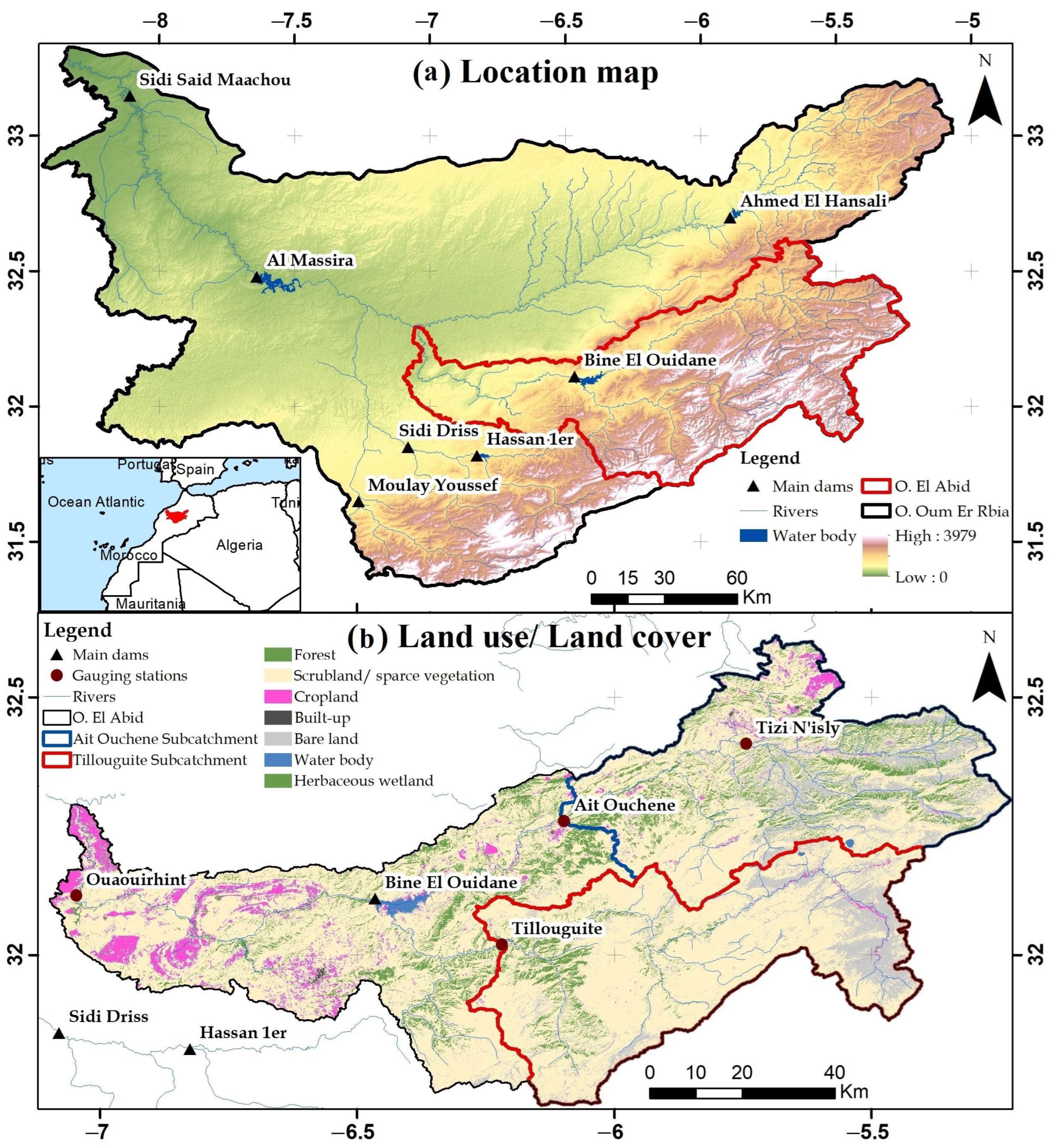
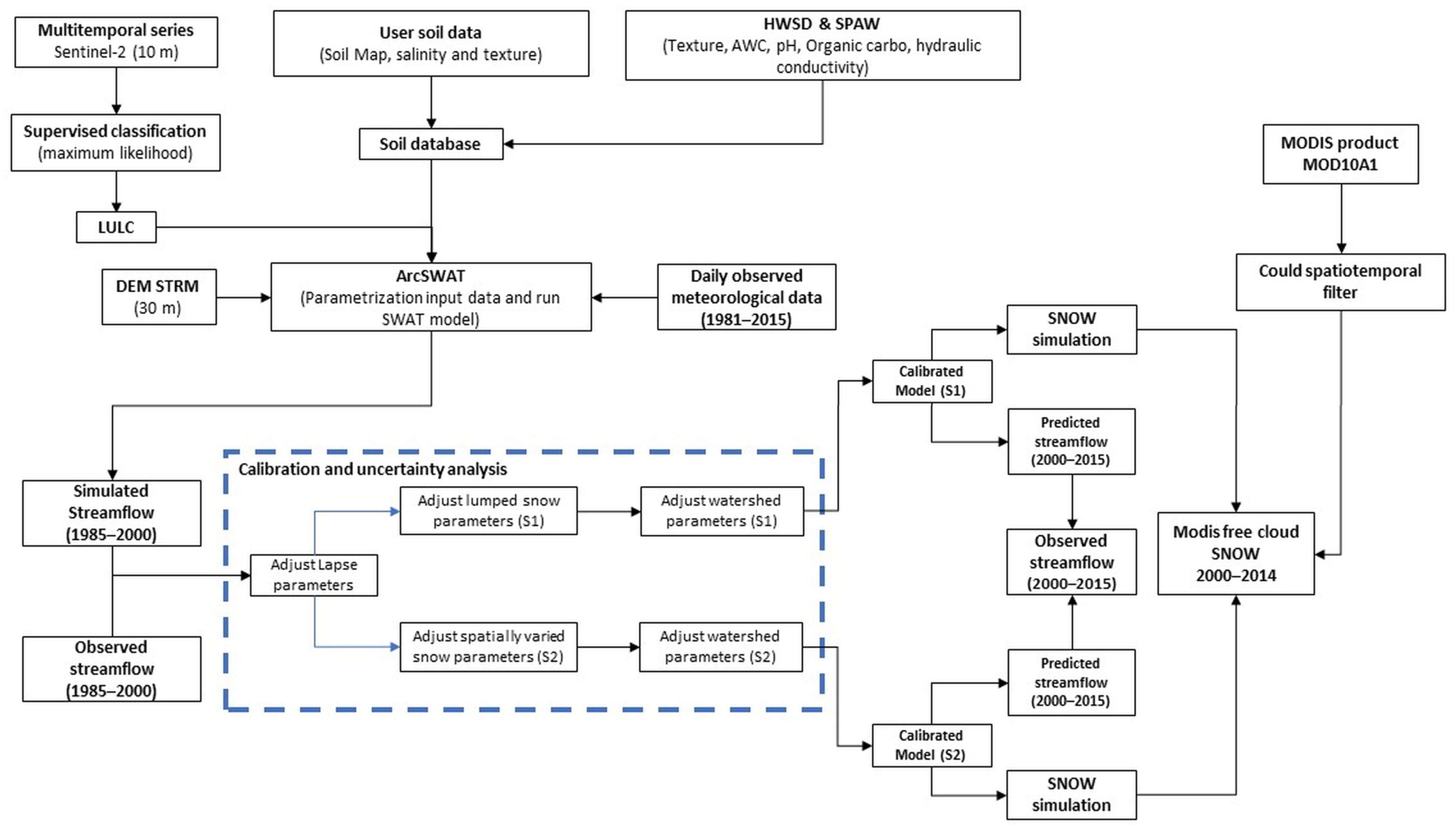


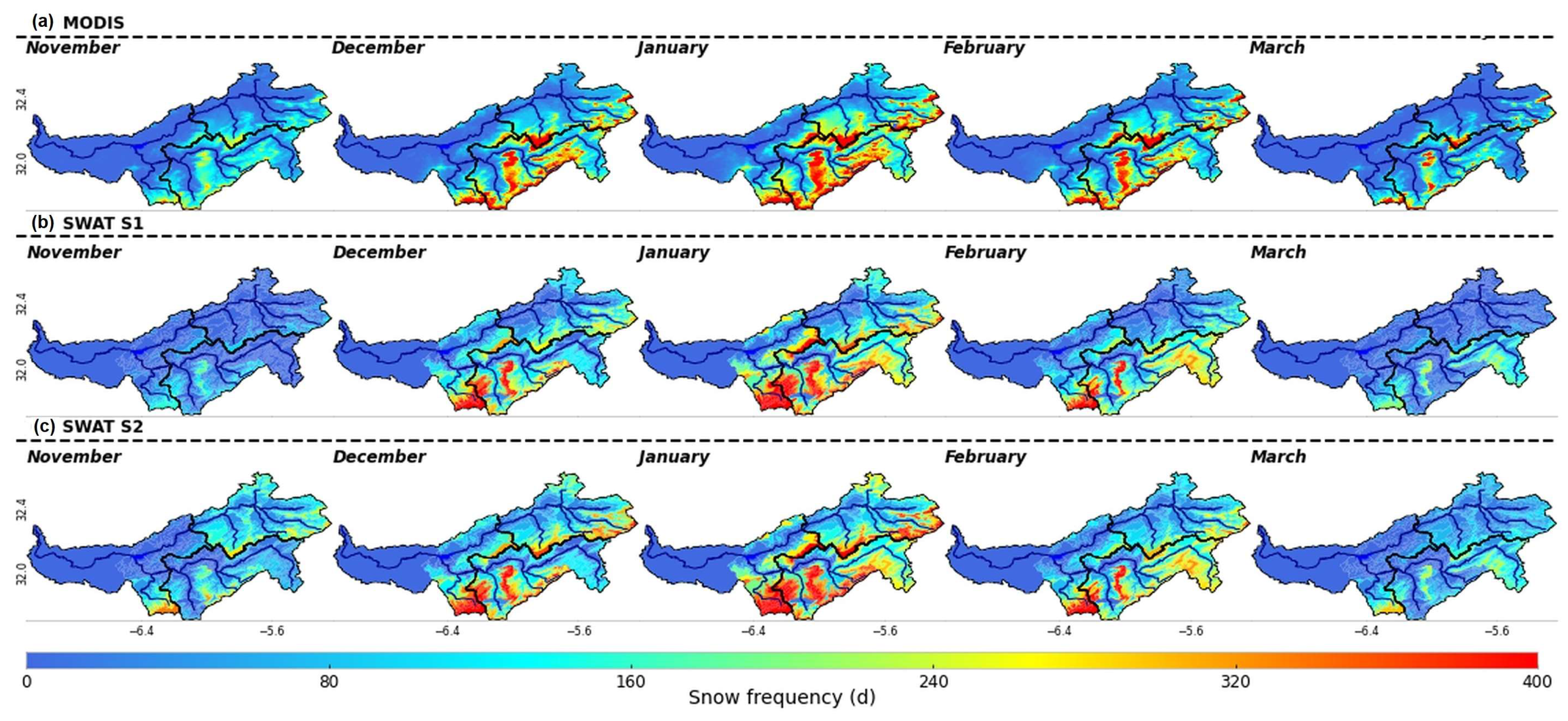
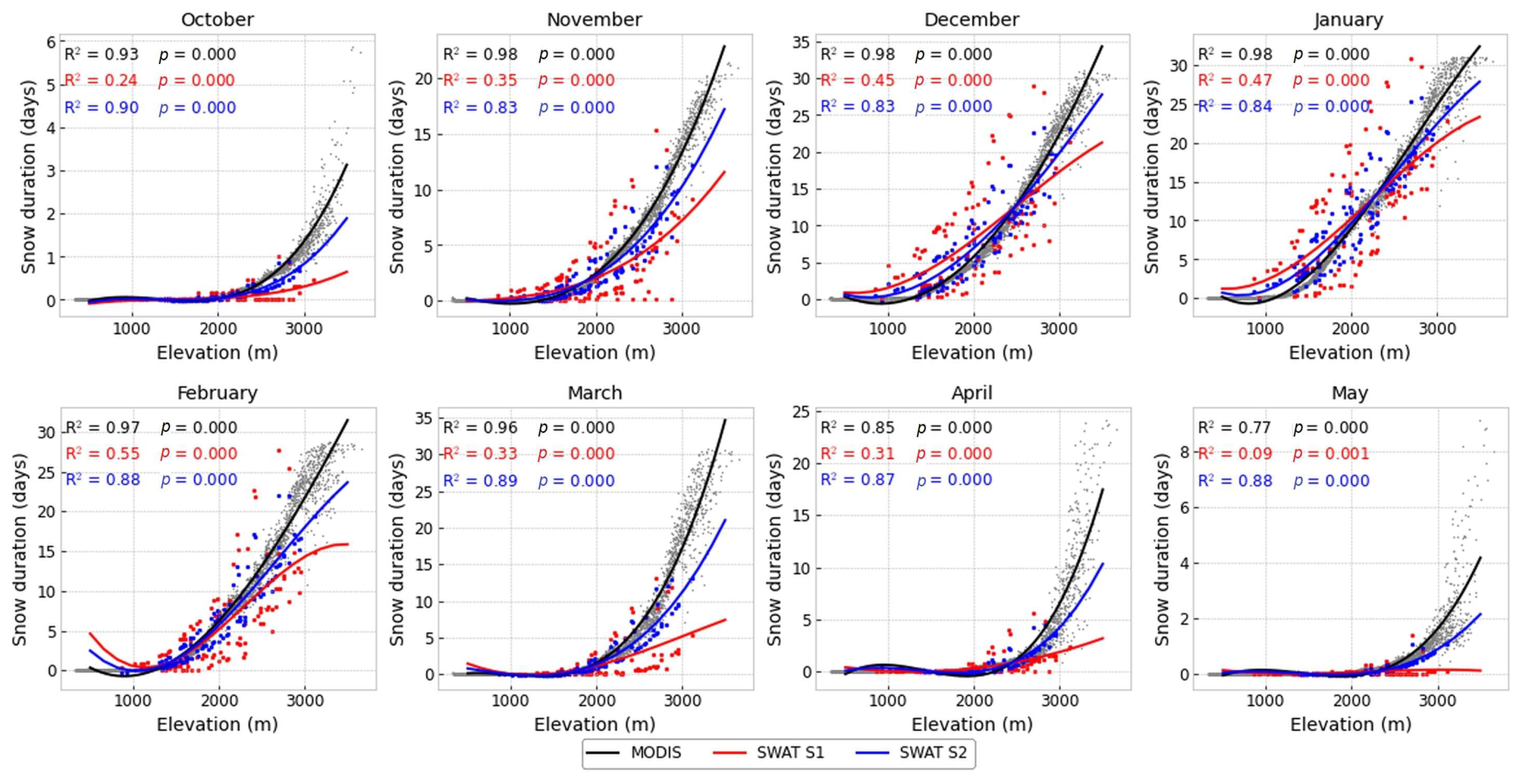
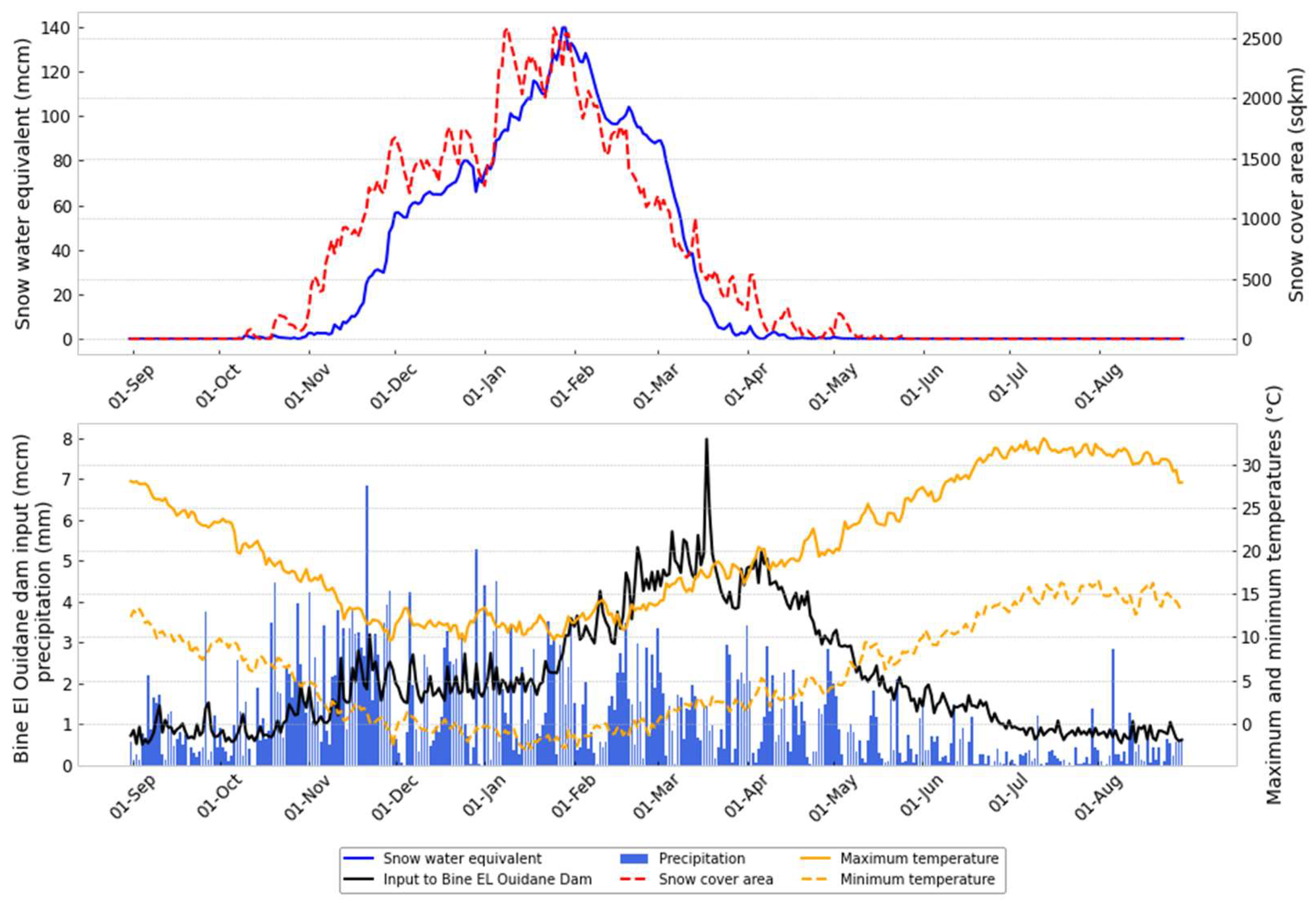

| Value of Pixel | Description |
|---|---|
| 0–100 | NDSI snow cover |
| 200 | Missing data |
| 201 | No decision |
| 211 | Night |
| 237 | Inland water |
| 239 | Ocean |
| 250 | Cloud |
| 254 | Detector saturated |
| 255 | Fill |
| Calibration | Validation | ||||||||||||
|---|---|---|---|---|---|---|---|---|---|---|---|---|---|
| Daily | Monthly | Daily | Monthly | ||||||||||
| NSE | PBIAS | P-Fact | R-Fact | NSE | PBIAS | NSE | PBIAS | P-Fact | R-Fact | NSE | PBIAS | ||
| Tizi N’Isly | S1 | 0.51 | −34.76 | 0.45 | 0.76 | 0.52 | −34.61 | 0.33 | −12.94 | 0.40 | 0.97 | 0.53 | −12.74 |
| S2 | 0.52 | −10.98 | 0.48 | 0.97 | 0.71 | −10.87 | 0.49 | −26.97 | 0.52 | 1.45 | 0.61 | −26.79 | |
| Ait Ouchene | S1 | 0.59 | −29.27 | 0.39 | 0.37 | 0.68 | −29.07 | 0.55 | −2.40 | 0.41 | 0.81 | 0.80 | −2.22 |
| S2 | 0.62 | −11.90 | 0.51 | 1.65 | 0.73 | −11.78 | 0.63 | −30.56 | 0.47 | 1.68 | 0.75 | −30.31 | |
| Bine El Ouidane | S1 | 0.60 | −9.43 | 0.52 | 0.72 | 0.84 | −9.26 | 0.52 | 10.15 | 0.41 | 0.73 | 0.82 | 10.24 |
| S2 | 0.60 | −17.56 | 0.55 | 1.15 | 0.69 | −17.43 | 0.59 | −7.73 | 0.49 | 1.18 | 0.79 | −7.52 | |
| Tillouguite | S1 | 0.42 | 10.53 | 0.45 | 0.96 | 0.89 | 10.75 | 0.44 | 18.28 | 0.43 | 1.09 | 0.83 | 18.33 |
| S2 | 0.49 | −6.94 | 0.52 | 1.38 | 0.89 | −6.72 | 0.48 | −3.79 | 0.55 | 1.89 | 0.84 | −3.75 | |
| Overall performances | S1 | 0.53 | −15.73 | 0.73 | −15.55 | 0.46 | 3.27 | 0.74 | 3.40 | ||||
| S2 | 0.56 | −11.85 | 0.76 | −11.70 | 0.55 | −17.26 | 0.75 | −17.09 | |||||
| Model | Ait Ouchene | Tillouguite |
|---|---|---|
| S1 | 5–15 | 10–25 mm |
| S2 | 10–20 | 10–30 mm |
| Timestep | NSE | PBIAS | |||
|---|---|---|---|---|---|
| S1 | S2 | S1 | S2 | ||
| Ait Ouchene sub-catchment | Daily | −0.4 | 0.14 | −171 | −21.11 |
| Weekly | −0.34 | 0.21 | −170.25 | −20.97 | |
| Monthly | −0.57 | 0.23 | −172.42 | −22.31 | |
| Tillouguite sub-catchment | Daily | 0.53 | 0.56 | −14.38 | −11.26 |
| Weekly | 0.64 | 0.65 | −14.12 | −11.00 | |
| Monthly | 0.73 | 0.76 | −14.26 | −11.14 | |
| Oued El Abid basin-wide | Daily | 0.49 | 0.54 | −40.6 | −31.48 |
| Weekly | 0.62 | 0.68 | −40.17 | −31.05 | |
| Monthly | 0.69 | 0.75 | −40.68 | −31.56 | |
Disclaimer/Publisher’s Note: The statements, opinions and data contained in all publications are solely those of the individual author(s) and contributor(s) and not of MDPI and/or the editor(s). MDPI and/or the editor(s) disclaim responsibility for any injury to people or property resulting from any ideas, methods, instructions or products referred to in the content. |
© 2023 by the authors. Licensee MDPI, Basel, Switzerland. This article is an open access article distributed under the terms and conditions of the Creative Commons Attribution (CC BY) license (https://creativecommons.org/licenses/by/4.0/).
Share and Cite
Taia, S.; Erraioui, L.; Arjdal, Y.; Chao, J.; El Mansouri, B.; Scozzari, A. The Application of SWAT Model and Remotely Sensed Products to Characterize the Dynamic of Streamflow and Snow in a Mountainous Watershed in the High Atlas. Sensors 2023, 23, 1246. https://doi.org/10.3390/s23031246
Taia S, Erraioui L, Arjdal Y, Chao J, El Mansouri B, Scozzari A. The Application of SWAT Model and Remotely Sensed Products to Characterize the Dynamic of Streamflow and Snow in a Mountainous Watershed in the High Atlas. Sensors. 2023; 23(3):1246. https://doi.org/10.3390/s23031246
Chicago/Turabian StyleTaia, Soufiane, Lamia Erraioui, Youssef Arjdal, Jamal Chao, Bouabid El Mansouri, and Andrea Scozzari. 2023. "The Application of SWAT Model and Remotely Sensed Products to Characterize the Dynamic of Streamflow and Snow in a Mountainous Watershed in the High Atlas" Sensors 23, no. 3: 1246. https://doi.org/10.3390/s23031246
APA StyleTaia, S., Erraioui, L., Arjdal, Y., Chao, J., El Mansouri, B., & Scozzari, A. (2023). The Application of SWAT Model and Remotely Sensed Products to Characterize the Dynamic of Streamflow and Snow in a Mountainous Watershed in the High Atlas. Sensors, 23(3), 1246. https://doi.org/10.3390/s23031246






